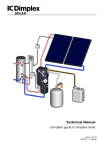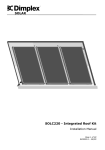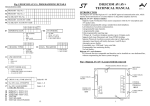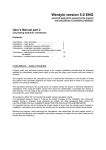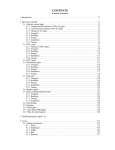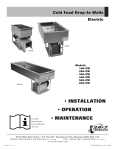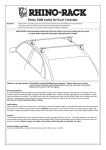Download Dimplex SOLAR ST0133 Technical data
Transcript
SOLAR SOLC220 – Free standing kit Installation instructions Page 1 of 20 ST0117 - C – 08/09 SOLC220 - Free standing kit SOLAR 0 Overall view Figure 1 – Overall view of installation method Page 2 of 20 ST0117 – C 08/09 SOLC220 - Free standing kit 1 Contents SOLAR 0 OVERALL VIEW 2 1 CONTENTS 3 2 BEFORE YOU START 4 GENERAL COMPETENCE HEALTH AND SAFETY RISK ASSESSMENT TOOLS REQUIRED EARTHING AND LIGHTENING PROTECTION 4 4 4 5 5 5 3 SCOPE OF DELIVERY 6 4 PRODUCT FEATURES AND DESCRIPTIONS 7 5 COLLECTOR CONNECTIONS 8 5.1 SINGLE COLLECTOR VERTICAL CONNECTION 5.2 MULTIPLE COLLECTOR VERTICAL CONNECTION 8 9 6 INSTALLATION 10 7 OPERATION 20 8 MAINTENANCE 20 9 DECOMMISSIONING 20 10 TECHNICAL DATA 20 Page 3 of 20 ST0117 – C 08/09 SOLC220 - Free standing kit 2 Before you start SOLAR General Thank you for choosing a Dimplex product. We ensure you that every effort has been made at the design, manufacture and delivery stages to produce a product with superior quality. We will provide you with the best possible support throughout the product’s lifespan. As part of ongoing product development and improvement Dimplex reserves the right to undertake changes to the product without prior notice. Great care has been taken to ensure this manual was correct at the time of print. Should you however discover any issues with the information contained therein please do not hesitate to contact your vendor. We strongly recommend reading the whole contents of this manual before commencing the work. Competence Dimplex products have been designed and manufactured to the current relevant standards and under stringent quality control. It is therefore imperative that the product is only installed by a: - trained and - competent person as defined in the relevant regulations. Dimplex does not accept any liability for damage done to persons or property resulting from undue handling and usage of this product. All regulations current at the time of installation are to be considered alongside the content of this manual as they form the code of best practice. The warranty of this product is linked to the ability to prove that the product was installed, commissioned and maintained: - by a competent person - in accordance with Dimplex instructions and the current relevant regulations and legislation - the product being registered with Dimplex at the time of installation using the form in the Dimplex On Site Guide - records showing the date of maintenance in accordance with the maintenance schedule as detailed in the On Site Guide Health and Safety The installation of this product is subject to the Health and Safety at Work Act. It is your responsibility to ensure that the transport, storage, installation and operation of the product is carried out in a safe manner. Dimplex will not accept any liability due to damage caused to people or property resulting from negligence or not adhering to the relevant Health and Safety practises. Page 4 of 20 ST0117 – C 08/09 SOLC220 - Free standing kit Risk assessment SOLAR The compilation of a risk assessment is strongly recommended before installing the product. The following areas require particular consideration in addition to the information required by the Health and Safety at Work Act. - scalding: where appropriate or required by law a thermostatic mixing valve is to be fitted to the hot water outlet of the cylinder - explosion: the unit is fully equipped with all relevant safety equipment to comply with current regulations. The correct design and function has been verified by independent third party testing. The correct application thereof is the responsibility of the competent installer. - water borne organisms (i.e. Legionella): if applicable a risk assessment should be carried out following the recommendations outlined in the Approved Code of Practise L8. - the user preference must be considered when commissioning the system, in particular when adjusting the solar and auxiliary system temperature and timer settings. Tools Required - 2 people required for installation Cordless drill 10mm wood or masonry drill bit 13mm socket wrench Spanners 13/17mm Measuring Tape Earthing and Lightening Protection If a lightening arrester is available, the collector frame should be connected to it. This may be preformed using the collector frame, because the slot for mounting on the reverse side of the collector is ideally suited for fixing a thick cable. If no arrester is available, the potential equalization is carried out using a connection of a cable at the tube(s) which are led in the building. Please consult local regulations to ensure adherence. Pipe Work The pipe work from the collector to the pump unit and from the pump unit to the cylinder is to be all metal. The joints have to be high temperature resistant (compression or high temperature flat seal). For more information please see Technical Manual – Complete guide to Dimplex Solar, ST0133. Page 5 of 20 ST0117 – C 08/09 SOLC220 - Free standing kit SOLAR 3 Scope of delivery Please check the contents and the condition of your delivery before signing the delivery documentation against the content shown in Table 1 below and mark as appropriate. Contact your supplier immediately for any missing or damaged parts. Claims for missing of damaged parts after signing for the delivery documentation will not be accepted. Table 1 – Scope of delivery Page 6 of 20 ST0117 – C 08/09 SOLC220 - Free standing kit 4 Product features and descriptions SOLAR The Dimplex Solar Free standing kit offers a simple and secure method of securing the SOLC220 solar collectors to a flat roof or any other flat mounting area. The collectors can be installed at angles from 45° to 60° with the basic kit. Shorter rear struts are available expanding the installation angles to 25° at the lower end. Due to the flexible connections between the collectors up to 10 collectors can be directly mounted together. Should more than 10 collectors be required the collector array has to be split into fields which are connected in parallel to each other. Figure 2 Single collector and two collector installations The area required (A x B) to install the free standing collector or collector array can be easily calculated from the formula, B = 1085mm + (n-1)1240mm where n represents the number of collectors from 1 to 10, A and C are read from table 2. C B A Figure 3 – Space requirements for free standing installation Table 2 – Space requirements for free standing installation Page 7 of 20 ST0117 – C 08/09 SOLC220 - Free standing kit 5 Collector connections SOLAR Because of its 4 connections, the collector offers a wide choice of connection options. Ensure that no part of the collector array or collector in the array is short circuited by following these instructions. When planning the collector array, the position of the various connection parts must be in accordance with the diagrams, also pay attention to the position of the highlighted sensor pockets. Table 3 illustrates the components required to make all the collector connection. Table 3 - Collector connection components 5.1 Single collector vertical connection When installing a single collector installation, there are two connection options available. Choice of connection option will be determined by suitability and location of the components in the solar system to one another, (pipe runs etc usually determine the choice). Figure 2 illustrates the left hand side connection option and the right hand side connection options that are applicable only to a single vertical collector connection. Figure 2 – Left hand side and right hand side connection options for single collector only Page 8 of 20 ST0117 – C 08/09 SOLC220 - Free standing kit 5.2 Multiple collector vertical connection SOLAR When installing multiple collectors, (2 up to 10), component 10.1 is used to connect one collector to the next. The flow and return connections must be at diagonals to one another as illustrated in Figure 3 and Figure 4. These diagrams highlight the two connection options available when connecting multiple collectors vertically in an array. When connecting up to five collectors in an array the flow and return connections can be made on the same side. Figure 3 - Multiple collector vertical connection, Option 1 The location of the sensor pockets should be noted upon installation, which is highlighted in Figure 3 and Figure 4. The orientation of the middle collector(s) is unimportant. The collector temperature senor should be installed at the collector flow, (flow to the cylinder). Figure 4 – Multiple collector vertical connection, Option 2 Page 9 of 20 ST0117 – C 08/09 SOLC220 - Free standing kit 6 Installation SOLAR Step 1.1 Fixing - Determine the dimensions of the whole collector array and mark the position of the U-pieces (3.1). - Distance A applies to the spacing between the U-pieces of the basic kit, distance D to all extension kits. - Dimension B relates to the distance between the U-pieces of adjacent collectors. - Dimension C is fixed at 1140mm. - The measurements relate to the middle of the U-piece components. - It is important to remember when installing the collectors, they must be installed from left to right only, (when facing the array from surface exposed to the sun). Step 1.2 Fixing - Before drilling the holes in the surface for the U-pieces, check the spacing using the diagonals. - Diagonals E and F must be of equal length, as must diagonals G an H. - Next, drill with the ø10 mm drill bit at the marked positions. - If drilling is not permitted on a flat roof due to the leak-tightness of the roof, appropriate concrete slabs or a similar material must be used as a foundation. Page 10 of 20 ST0117 – C 08/09 SOLC220 - Free standing kit SOLAR Step 1.3 Fixing - Use the rawlplugs (3.4) and fasten the U-pieces (3.1) with washers (3.3) and bolts (3.2). - If U-rails are being used, also fasten these with washers (3.3) and bolts (3.2). Step 1.4 Fixing - Attach the supporting tube (2) to the rear U-pieces (3.1) with an M10 hexagonal bolt (3.6), spring washer (3.7) and hexagonal nut (3.8). - Put the protective cap (3.5) on the supporting tube. - Screw the bolt tight enough so that the supporting tubes can be mounted upright. Step 2.1 Collector - Lift two of the square nuts in the slot on the back of the collector (1) with a screwdriver and hold them with the installation aid (4.4). - Using the installation aid, the nut can easily be positioned for further installation of the T-pieces when the collector (1) has been erected. Page 11 of 20 ST0117 – C 08/09 SOLC220 - Free standing kit SOLAR Step 2.2 Collector - Preassemble four T-pieces (4.1) for each collector with M8 hexagonal bolts (4.2) on the square nuts in the slot on the rear of the collector (1). - To do so, align the first square nut with the help of the long side of the installation aid (4.4). - Attach the T-piece and screw in a hexagonal bolt. - Align the second square nut by turning the installation aid and screw in another hexagonal bolt. Step 2.3 Collector - Determine the definitive lower spacing of the T-pieces (4.1) on the collector (1). - To do so, make sure the spacing G of 40 mm from the bottom edge of the collector for the lower T-pieces is observed. - Screw the T-pieces tightly. - To avoid damage to the collector, the spacing G of 40 mm must be observed. Page 12 of 20 ST0117 – C 08/09 SOLC220 - Free standing kit SOLAR Step 2.4 Collector - Determine the definitive upper spacing of the T-pieces (4.1) on the collector. - The mounting angle is determined by the spacing H between the two Tpieces. - Screw the T-pieces tightly. - For mounting options 30°, 35° and 40° component 2.1 (rear strut 740mm long) must be used. Step 2.5 Collector - Punch the two drainage holes at each BOTTOM corner of the collector, according to how it is mounted, with the aid of a slotted screwdriver. - To do so, punch at the bottom edge. - To ensure that water can drain properly from the collector, it is absolutely essential that all drainage holes are punched at the bottom corners (depending on how the collector is mounted on the kit). Page 13 of 20 ST0117 – C 08/09 SOLC220 - Free standing kit SOLAR Step 2.6 Collector - Have the M10 hexagonal bolts (3.6), large spacer sleeves (3.9), spring washers (3.7) and M10 hexagonal nuts (3.8) ready for fastening the collector. - If laying the collector on the surface for a short time, it may be necessary to use an underlay to avoid damage to the frame. - The help of a second person is required to position the collector and fix it in place. The collector must NOT be rested on the back pane or the glass. It must always be supported on the frame! Step 2.7 Collector The above step (Step 2.7) gives an overview of the collector fixings and connections. The highlighted areas (1, 2, 3 and 4) are presented in more detail below in the next five steps. Page 14 of 20 ST0117 – C 08/09 SOLC220 - Free standing kit SOLAR Step 2.7.1 Collector - Attach the collector (1) to the front Upieces (3.1). - To do so, position the collector with the help of a second person. - Attach the T-pieces (4.1) to the Upieces using M10 hexagonal bolts (3.6), large spacer sleeves (3.9), spring washers (3.7) and M10 hexagonal nuts (3.8). Step 2.7.2 Collector - Slowly tilt the collector (1) towards the supporting tubes (2). - Attach the T-pieces using M10 hexagonal bolts (3.6), large spacer sleeves (4.3), spring washers (3.7) and M10 hexagonal nuts (3.8). - Fasten all four T-pieces in place by tightening the M10 hexagonal bolts. Page 15 of 20 ST0117 – C 08/09 SOLC220 - Free standing kit SOLAR Step 2.7.3 Connections - Fit the insert rings onto the corrugated interconnection component. - Ensure two insert rings are inserted into the 4th and 5th trough from both ends of the component. - The insert rings must be securely pressed together around the circumference of the corrugated pipe. - Coat the o-rings of the corrugated pipe compensators (6.1) with grease (5.5) and fit one of them in each of the connection of the pre-assembled collector. - The compensators must be slid into the connections of the collector until the first insert ring is flush with the end of the collector connection. O-rings Free corrugation 2 x insert rings - Ensure that the o-rings sit tight in their fittings. Step 2.7.4 Collector - Fix the upper T-pieces (4.1) to the supporting tubes (2). - To do so, preassemble the T-pieces using M10 hexagonal bolts (3.6), large spacer sleeves (4.3), spring washers (3.7) and M10 hexagonal nuts (3.8). - Keep supporting the collector until all M10 hexagonal bolts have been attached. Page 16 of 20 ST0117 – C 08/09 SOLC220 - Free standing kit SOLAR Step 2.7.5 Collector - Preassemble the lower T-pieces to the U-pieces using M10 hexagonal bolts (3.6), large spacer sleeves (3.9), spring washers (3.7) and M10 hexagonal nuts (3.8). - Keep supporting the collector until all M10 hexagonal bolts have been attached. - Screw tight all M10 hexagonal bolts with spring washers and M10 hexagonal nuts. Step 3.1 Connections The remaining interconnections made, ensuring that; are - Insert rings (6.2) are placed in the 4th and 5th trough of the corrugated pipe (6.1), counted from the end, on the side faced next to the collector. - The insert rings must be securely pressed around the circumference of the corrugated pipe. - Next insert the corrugated pipe (6.1) until blocked by the 1st insert ring. Step 3.2 Connections - Pull clamps (6.3) over the collector connections and the outer insert rings, then press with adjustable pliers or grips and fix it using the screw. - Make sure that the outer insert ring is completely covered by the clamp. Page 17 of 20 ST0117 – C 08/09 SOLC220 - Free standing kit SOLAR Step 3.3 Connections - Coat in O-rings of the connection pipe (5.1) with the grease (5.5). - Position the insert rings (5.6) in the 4th and 5th trough of the corrugated pipe, counted from the end. - Next insert the connection pipe into the collector connection until the outer insert ring is flush with the outside of the collector tulip. Step 3.4 Connections - Pull clamps (5.3) over collector connections and outer insert ring, using pliers or an adjustable spanner press the clamp closed so the screw secures it. - Make sure the outer insert ring is covered by clamp. Step 3.5 Connections - Coat the o-rings on the end piece (5.2) with grease (5.5). - Insert the end piece tightly into the collector connection. - Next pull the clamp (5.3) over collector connections and outer insert rings. - Press the clamp with pliers or an adjustable spanner so the screw secures the clamp in position. Page 18 of 20 ST0117 – C 08/09 SOLC220 - Free standing kit SOLAR Step 4.1 Sensor - Carefully remove the grommet from the collector housing. - Slide the grommet over the temperature sensor (included with the solar controller). - Insert the temperature sensor fully into the immersion sleeve. Seal the collector frame using grommet. Ensure correct placement of the grommet. Step 5.1 - Please refer to the ‘On site guide’ for details on pressure testing, testing for leaks and proper maintenance of the system. - Upon completion of testing for leaks, please ensure that all the pipe work is properly insulated. Page 19 of 20 ST0117 – C 08/09 SOLC220 - Free standing kit 7 Operation SOLAR Although there are no operational components in the free standing kit, the fixings should be tightened and double checked prior to commissioning of the system. Please refer to the On Site Guide for guidance on how to commission and operate the solar system. 8 Maintenance Risk of scalding! Before carrying out any maintenance work on the system ensure that it is safe to do so. The solar system must be decommissioned before work can be carried out. Refer to the On Site Guide for a maintenance schedule of the complete system. However some basic checks can be made, for example, check for leaks at the collector connections and other connections in the system. Also ensure pipe insulation is intact and in good condition. 9 Decommissioning Risk of scalding! Before carrying out any decommissioning work on the free standing kit, please ensure the solar system has been decommissioned. If the product is being recycled, local waste disposal laws must be adhered to. 10 Technical Data Page 20 of 20 ST0117 – C 08/09




















